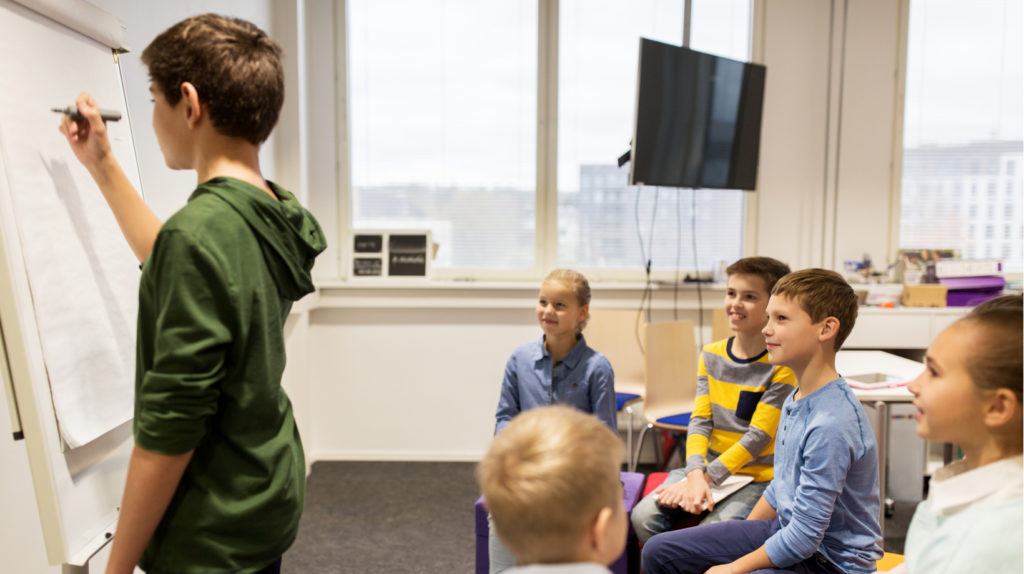Why Flipped Classrooms Are The Key To Creating An eLearning Ecosystem
eLearning has evolved magnificently, resulting in a clear shift in the channel of imparting knowledge. From conventional channels to internet-based channels, eLearning has overseen this change with great success.
We are now used to gamified content, interactive tests, and an rich, enhanced student experience. But what comes next?
In the new age, eLearning is taking a step further, towards building a culture of cohesive learning. As the term suggests, cohesive learning is all about creating a complete environment that for all-round learning. No longer will the student have to hunt through independent stacks of information to understand concepts.
In other words, you could say, this would be the ideal eLearning Ecosystem.
Let’s explore the idea in greater detail.
What Is An eLearning Ecosystem?
To understand this, we must first revisit what an ‘ecosystem’ means:
“An ecosystem is an arrangement where living organisms sustain harmoniously in a given environment.”
What’s interesting is that all the members of the ecosystem interact with each other in a mutually beneficial manner. The sustenance of the ecosystem depends on the interaction between the living organisms and the environment.
Coming to eLearning, the objective of an ideal learning system is to impart quality education. This can be achieved by creating an eLearning ecosystem, with effective communication between the members of the ecosystem - Students, Instructors, and Technology.
Such communication, when optimized, leads to an eLearning culture - a positive culture dedicated to increasing the efficiency and the harmony of the ‘eLearning ecosystem’.
The idea of eLearning ecosystems is based on the convergence of worldwide courses in a blended manner. Also, there is an emphasis on the emotional side of the learner with an aim of getting over the restrictions caused by lack of communication between learners.
However, defining this ecosystem is easy enough, but creating it the conventional way is easier said than done.
The Problems With Creating An eLearning Ecosystem The Conventional Way
You might say, what’s wrong with using good old-fashioned techniques to build an eLearning ecosystem? We have a conventional LMS, some nifty add-ons, and perhaps a handful of instructors who conduct great courses. Looks pretty good.
But if you get down to the nitty-gritty of the matter, you see that the interaction between all these elements is far from frictionless. Independently they might be working fine, but together they lack cohesion.
It's not difficult to see the challenges traditional eLearning systems face.
Learners feel secluded, which also means that there is less collaboration between them. Although this is remedied to an extent by the addition of social forums and interactive lessons, there is still a persistent feeling of isolation in the mind of the learner.
The role of the educator becomes more of a narrator as he/she has limited ways of checking whether a student has understood a concept completely.
There are other problems that affect the efficiency of a typical LMS-based ecosystem as well. Some of these are:
- Lack of application-based learning
In a conventional environment, a major part of a course goes in disseminating basics of the topic and then checking if the learners have grasped the topics through assignments. Ensuring this takes up the whole course that ends up with examination. Clearly, there is no stress on an application-based strategy of learning. - The clerical burdens of instructors
The educator is overburdened with continuous assessment of the assignments and subsequently of examinations. There is lack of time and opportunity for the educator to be creative in imparting learning. - A broken study cycle
There is a lack of tendency found in learners to apply the corrections from their assignments. This leaves the learning cycle incomplete.
This creates friction, hence disturbing the eLearning ecosystem.
So how do we overcome these problems?
Flipped Learning To The Rescue
The shortcomings of the traditional eLearning modules can be overcome with flipped learning. For those of you who are new to the idea of flipped learning [1], here is a short introduction:
Two veteran Chemistry teachers in Woodland Park High School, Jonathan Bergmann and Aaron Sams, began uploading the videos of their lectures for students who had missed the classes (2012). Apparently, the students who didn’t miss the classes found the videos useful as well. This led to what is known as ‘Flipped Learning’; an alternate approach to the conventional style of teaching that is changing the way we look at efficiency from a learning system.
In Flipped Learning, the conventional classroom method is reversed in a sense that students are first exposed to the study material provided in advance and then the classrooms happen. The classroom time is used for application-based activities right from the start as the learners are expected to come prepared with the basics of the topics from the study material provided beforehand. The classroom can start directly with meaningful discussions, query solving, etc., before quickly moving on to collaborative activities that teach to apply the principles in practicality.
Flipped Learning takes all the homework activities like research work, group assignment work and project work to the classroom. It also shifts all the traditional classroom activities like studying about the topic or lesson through understanding its basics and so forth to homework activity.
Creating An eLearning Ecosystem With Flipped Learning
As we have seen before, an ecosystem is a well-sustained environment and is formed with “the complex of living organisms, their physical environment, and all their interrelationships in a particular unit of space” (Britannica).
Flipped Learning serves exactly the purpose of creating an eLearning ecosystem. It fits in the definition of an ecosystem (Learning and Performance Ecosystems by Marc J. Rosenberg and Steve Foreman) that it is a “learning and performance ecosystem that includes enhancing individual and organizational effectiveness by connecting people, and supporting them with a broad range of content, processes, and technologies to drive performance.”
Flipped Learning effects a virtual role-reversal for the students and the teacher. In a conventional setting, the teacher serves as the center for information dissemination and has this responsibility of teaching the learners all the concepts within a lesson.
In a Flipped Classroom, the student has the responsibility of learning the topics and understanding them through the study material (videos, audio, text file, slideshows, references, and external links) provided by the teacher. So in this way, Flipped Learning places more learning opportunities directly into the flow of the work, just as expected from a learning ecosystem.
Marc J. Rosenberg and Steve Foreman mentioned in their white paper that existing paradigms of blended learning, human-performance technology, and informal learning are notable efforts in attempts to build effective eLearning ecosystems. Flipped learning uses all these paradigms in its functioning.
Real-Life Flipped Learning Ecosystems
There are several instances where institutes and eLearning organizations have adopted flipped learning in an effort to create the quintessential eLearning ecosystem. In addition, innovative eLearning solutions are being developed that leverage the power of flipped learning to build a cohesive learning ecosystem.
Salman Khan founded Khan Academy [2] that uses the flipped classroom model, although it's only a type of flipped learning and flipped learning in itself stands for various types of possibilities in terms of executing the model. For example 'Flipped the teacher’ is a format of flipped learning where students are asked to make videos to demonstrate learning.
eLucid is an eLearning solution that incorporates the principles of flipped learning in a corporate scenario. In addition to having a plethora of tools for creating engaging, interactive content and detailed reporting and analysis methods, eLucid implements the idea of flipped learning to enhance collaboration between employees.
The Last Word
It is evident that our capacities to adopt newer, more creative approaches in learning systems will determine the success of the eLearning sphere. We need to provide accurate, complete resources so that students learn in a more sophisticated manner. It is time to move away from ‘one-off’ solutions to more comprehensive and multi-dimensional solutions that comprise of multifaceted learning and performance options that increase the efficiency of the learning environments we create.
eLearning ecosystems are an excellent way to enhance the complete student experience and flipped learning can become a useful tool for creating such an ecosystem, away and above conventional eLearning methods.
What are your thoughts on using flipped learning as a means of building an eLearning ecosystem? Any other ways you would recommend? Drop a comment to let me know!
References:
[1] Higher Education Academy, 2017. "Flipped learning." Accessed May 31, 2018. https://www.heacademy.ac.uk/knowledge-hub/flipped-learning-0
[2] Khan Academy. https://www.khanacademy.org









